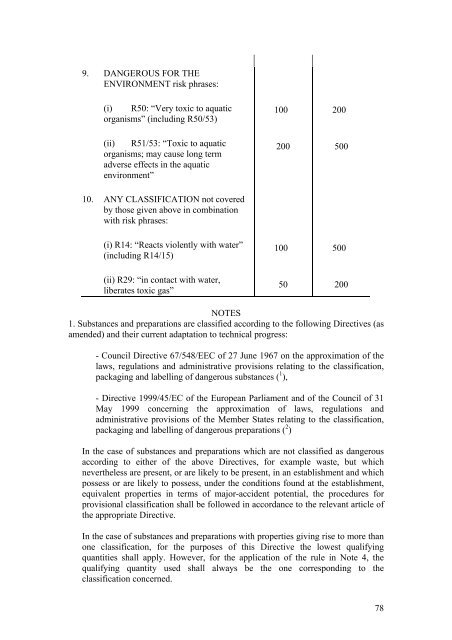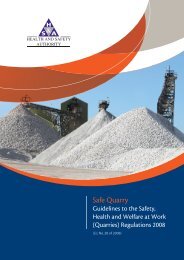Control of Major Accident Hazards Involving Dangerous Substances
Control of Major Accident Hazards Involving Dangerous Substances
Control of Major Accident Hazards Involving Dangerous Substances
You also want an ePaper? Increase the reach of your titles
YUMPU automatically turns print PDFs into web optimized ePapers that Google loves.
9. DANGEROUS FOR THE<br />
ENVIRONMENT risk phrases:<br />
(i) R50: “Very toxic to aquatic<br />
organisms” (including R50/53)<br />
(ii) R51/53: “Toxic to aquatic<br />
organisms; may cause long term<br />
adverse effects in the aquatic<br />
environment”<br />
10. ANY CLASSIFICATION not covered<br />
by those given above in combination<br />
with risk phrases:<br />
100<br />
200<br />
200<br />
500<br />
(i) R14: “Reacts violently with water”<br />
(including R14/15)<br />
100<br />
500<br />
(ii) R29: “in contact with water,<br />
liberates toxic gas”<br />
50<br />
200<br />
NOTES<br />
1. <strong>Substances</strong> and preparations are classified according to the following Directives (as<br />
amended) and their current adaptation to technical progress:<br />
- Council Directive 67/548/EEC <strong>of</strong> 27 June 1967 on the approximation <strong>of</strong> the<br />
laws, regulations and administrative provisions relating to the classification,<br />
packaging and labelling <strong>of</strong> dangerous substances ( 1 ),<br />
- Directive 1999/45/EC <strong>of</strong> the European Parliament and <strong>of</strong> the Council <strong>of</strong> 31<br />
May 1999 concerning the approximation <strong>of</strong> laws, regulations and<br />
administrative provisions <strong>of</strong> the Member States relating to the classification,<br />
packaging and labelling <strong>of</strong> dangerous preparations ( 2 )<br />
In the case <strong>of</strong> substances and preparations which are not classified as dangerous<br />
according to either <strong>of</strong> the above Directives, for example waste, but which<br />
nevertheless are present, or are likely to be present, in an establishment and which<br />
possess or are likely to possess, under the conditions found at the establishment,<br />
equivalent properties in terms <strong>of</strong> major-accident potential, the procedures for<br />
provisional classification shall be followed in accordance to the relevant article <strong>of</strong><br />
the appropriate Directive.<br />
In the case <strong>of</strong> substances and preparations with properties giving rise to more than<br />
one classification, for the purposes <strong>of</strong> this Directive the lowest qualifying<br />
quantities shall apply. However, for the application <strong>of</strong> the rule in Note 4, the<br />
qualifying quantity used shall always be the one corresponding to the<br />
classification concerned.<br />
78
















